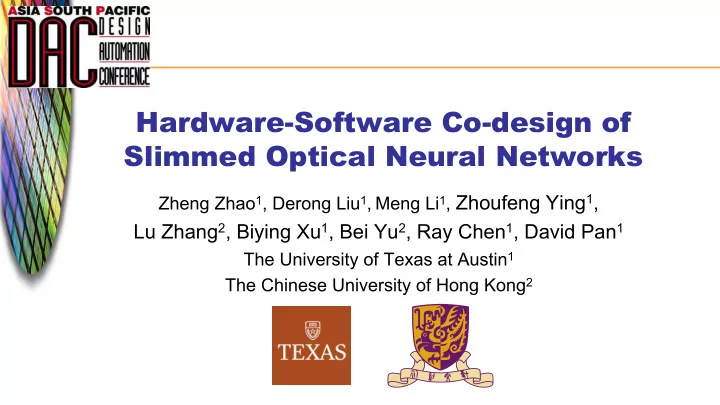

Hardware-Software Co-design of Slimmed Optical Neural Networks Zheng Zhao 1 , Derong Liu 1 , Meng Li 1 , Zhoufeng Ying 1 , Lu Zhang 2 , Biying Xu 1 , Bei Yu 2 , Ray Chen 1 , David Pan 1 The University of Texas at Austin 1 The Chinese University of Hong Kong 2
Introduction Emergence of dedicated AI accelerators t › Optical neural network processor: light in and light out » Speed-of-light floating point matrix-vector multiplication » >100GHz detection rate » Ultra-low energy consumption if configured › Great number of components, sensitivity to noise [Shen+, Nature Photonics 2017]
Previous Optical Neural Network (ONN) SVD decompose W = U Σ V* t Input Hidden Output layer layer layer U and V* are unitary matrices t › A unitary X satisfies XX* = I › Implemented by Mach-Zehnder Most area expensive … interferometers array Σ is a diagonal matrix t › Diagonal values are non-negative real W › Implemented by optical attenuators σ is non-linear activation in σ out U V* Σ t › Implemented by saturable absorber [Shen+, Nature Photonics 2017] 3
Implementing Unitary U and V* Mach-Zehnder interferometers (MZI) for U and V* t › A single MZI implements a 2-dim unitary coupler coupler ϕ out in › An array of n(n-1)/2 MZIs implements an n-dim unitary i th row T i,j … … in out j th row … i th col. j th col. Given an n-dim unitary, φ’s can be uniquely computed t 4
Previous ONN overview (m x n) W (n x 1) (m x 1) in σ out U Σ V* (m x m) (m x n) (n x n) t Layer size measured by # of MZIs = m(m-1)/2+n(n-1)/2 t Software training and hardware implementation › Train W directly in software à SVD-decomp to obtain U , Σ , V* Software Optical Training Implementation SVD decomp W U V* Σ
Slimmed Architecture (m x n) W (m x 1) (n x 1) in out σ T U Σ (m x n) (n x n) (n x n) t T: sparse tree network t U: unitary network same constraints as the previous architecture t Σ: diagonal network t Use less # of MZIs = n(n-1)/2 › 1 unitary matrix to maintain the expressivity › An area-efficient tree network to match the dimension 6
Co-design Overview t An arbitrary weight W is not TUΣ-decomposable t Co-design solution: training and implementation are coupled › T and Σ : Train the device parameters, constraints embedded › U: Add unitary regularization then approximate with true unitary Software Optical Training Implementation = T T Previous Train and Impl. Software Optical U Approx. Training Implementation SVD with U decomp reg. W U Σ V* = Σ Σ 7
Sparse Tree Network t Sparse Tree network ( T ) to match the different dimension › Suppose in-dim > out-dim › α: linear transfer coefficient x 1 y x 2 … … 1st subtree x N N x 1subtree out in 2nd subtree 3rd subtree 8
Sparse Tree Network Implementation t Implemented with MZIs or directional couplers t A 2 x 1 subtree x 1 y x 2 2 x 1 subtree can be Implemented with a single-out MZI or directional coupler coupler coupler ϕ out in (energy conservation) 9
Sparse Tree Network Implementation t Any N -input subtree with arbitrary α ’s satisfying energy conservation can be implemented it by cascading ( N-1 ) single-out MZIs. t Energy conservation embedded in training Software Optical Training Implementation = T T U Approx. with U reg. = Σ Σ
Unitary Network in Training t For unitary network U satisfying UU* = I , add the regularization reg = ∥ UU* − I ∥ F t Training loss function Loss = Data Loss + Regularization Loss leading to a near-implementable ONN with high accuracy t Trained U t ~ unitary but only true unitary is implementable by MZIs 11
Unitary Network in Implementation t Approximate U t by a true unitary U a t SVD-decompose U t = PSQ * à U a = PQ* t Claim. Minimize the regularization ⇔ find the best approximation Min. reg ⇔ Min. || U t - U a || F Software Optical Training Implementation = T T U Approx. with U reg. = Σ Σ
Simulation Results t Implemented in TensorFlow for various ONN setup N1: (14 � 14)-100-10 N4: (14 � 14)-150-150-10 N7: (14 � 14)-150-150-150-10 N2: (14 � 14)-150-10 N5: (28 � 28)-400-400-10 N8: (28 � 28)-400-400-200-10 N3: (28 � 28)-400-10 N6: (28 � 28)-600-300-10 N9: (28 � 28)-600-600-300-10 t Tested it on Intel Core i9-7900X CPU and an NVIDIA TitanXp GPU t Performed on the handwritten digit dataset MNIST 13
Simulation Results # of MZIs • N1~N9: network configurations • Our architecture uses 15%-38% less MZIs Accuracy • Similar accuracy (~0 accuracy loss) • Maximum loss is 0.0088 • Average is 0.0058
Noise Robustness t Better resilience due to less cascaded components Previous ONN Our ONN Accuracy Accuracy Noise Amplitude Noise Amplitude 15
Training Curve Regularization Regularization Accuracy Accuracy Epoch Epoch Regularization Accuracy • Converged in 300 epochs • Balance of the accuracy and the unitary approximation Epoch 16
Contributions of This Work t An new architecture for ONN › Area-efficiency › ~0 accuracy loss › Better robustness to noise t Hardware and software co-design methodology › Software-embedded hardware parameters › Hardware constraints guaranteed by software 17
Future Work t Better MZI pruning methods › ~0 phase MZI à pruned + accuracy recover › MZI-sparse unitary matrix t Design for robustness › Adjust noise distribution in training t Online training t ONN for other neural network architectures › CNN, RNN, etc. 18
19
Recommend
More recommend